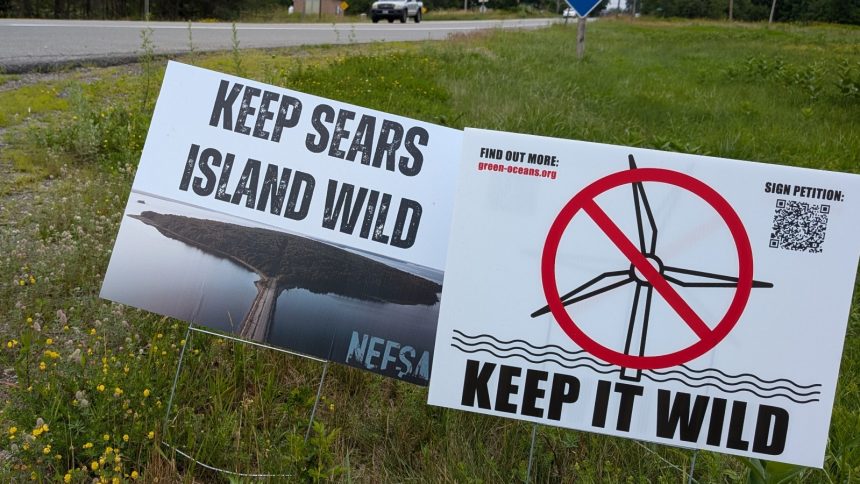This story was co-published by Energy News Network, the Maine Monitor, and Grist. Ron Huber rifled through a thick folder full of decades of state environmental records outside a community hall in the tiny coastal Maine town of Searsport. For the longtime local conservation activist, the scene inside was a familiar one: Dozens of neighbors, workers, and environmentalists mingled over pizza and coffee, discussing the merits of a proposed industrial project that has potential to transform the local economy, but at the expense of a locally beloved natural area.
“We’ve seen these things rise and fall many times,” Huber said outside the event late this past spring. Conservationists have celebrated over the decades as plans for a coal plant and a liquefied natural gas terminal on Sears Island came and went without success. This latest proposal presents a new kind of conflict. Rather than pitting townspeople against a corporate polluter, this development would support clean energy and be integral to the state’s plan for cutting climate emissions.
In May, the state applied for a $456 million federal grant to build a specially designed port on about 100 acres of Sears Island to support Maine’s nascent floating offshore wind industry. About two-thirds of the 941-acre island is in permanent conservation, and the state retains an easement on the rest, which has been reserved for a potential port for years.
“We’re not optimistic that this one’s going to die under its own weight,” Huber said, noting that the offshore wind port has far more popular support than previous development proposals.
Visits to recent community events like this one show that, unlike the polarized fights over clean energy projects in other parts of the country, Maine’s wind port is creating more personal divides — challenging residents’ values around climate change, conservation, and economic factors. It previews what could be coming as wind grows in the Northeast.
A sign, as seen on Sears Island on July 5, urges the state to build its planned wind port on nearby Mack Point, a developed area, instead of on the island. Annie Ropeik / Energy News Network
“My question is really about why we’re not actually all on the same team,” said Belfast, Maine, resident Julianne Dow inside the community hall, during a Q&A period with New England labor organizers. “I’m very pro-union, I’m pro-offshore wind, and pro having it here, and for the economic benefits for the region. But I’m also very pro maintaining Sears Island as a precious Midcoast resource.”
Dow and activists like Huber want the port built instead at a Sprague Energy-owned oil and logistics terminal across the water known as Mack Point. It was considered as an alternative in lengthy public processes in recent years, and Sprague and opponents of the Sears Island proposal have continued to urge reconsideration for it so far this summer.
Offshore wind has taken some big steps forward in Maine this year. Federal regulators approved a state research array of floating turbines, which generate power in deep waters far offshore, and are nearing leasing for commercial projects. A new state law calls for Maine to procure 3 gigawatts of offshore wind by 2040, using union-standard labor to build the projects and a floating wind-focused port. Formal environmental assessments and site analyses are still pending. But state port authority director Matthew Burns wrote in June that Mack Point’s “physical and logistical constraints, need for significant dredging, and increased costs to taxpayers for land leasing and port construction would result in an expensive and inferior port for Maine compared to a versatile, purpose-built port on Sears Island.”
Still, opponents worry that wetlands and forests on Sears Island could be disrupted by port construction, even if most of the surrounding ecosystem remains intact.
“Because we have to sacrifice something, let’s sacrifice something irreplaceable, instead of cleaning up a dirty old existing port?” Huber said outside the event. “That’s just ridiculous.”
Asked if he saw wind as a climate solution more broadly, Huber began to express doubts about how turbine arrays would affect the ocean ecosystem. Fellow opponent Lou MacGregor of Belfast cut in.
“Right now, what we’re focusing on is protecting Sears Island,” MacGregor said. “We can get to whether we support offshore wind or not after we protect Sears Island.”
Birders use binoculars to look for spring warblers on Sears Island as part of a trip organized by the Midcoast chapter of Maine Audubon. Annie Ropeik / Energy News Network
Scott Cuddy, the executive director of the Maine Labor Climate Council, emphasized at the recent event that his group is agnostic about the port’s location, focusing instead on the benefits it could bring. Under Maine’s wind procurement law, he said, the port’s labor standards will be the same wherever it ends up.
“We desperately want to see this happen because we need to fight climate change, and we need to do it with good jobs,” Cuddy said.
Cuddy and other labor organizers said state studies indicate that the port project and new wind farms could bring thousands of jobs to coastal Maine towns like Searsport. Local leaders said it could be a boost for shrinking school populations, attracting families to stay in the town long term.
“I think there’s been a mindset for a long time among kids, especially in rural Maine, like this was the thing I always heard: ‘You got to leave the state if you want to get a good job,’” said Sam Boss, the director of apprenticeships, workforce, and equity for the Maine AFL-CIO. “We’ve got to find ways to keep our people here. And if there’s good opportunities, people will stay for them.”
Boss, Cuddy, and others answered locals’ questions about plans for training programs for young people to enter the trades, and the family-sustaining wages and benefits promised by the growing wind industry — both in short-term construction positions and into the future.
“These are the skills that pay the bills, and they’re skills that don’t go away. The work might change — you know, we went from nuclear power plants, to now we’re doing offshore wind power development. But the skills are transferable,” said Nicki Kent, a union electrician who came to talk about her experience working on offshore wind in Rhode Island. “We’ve just got to get screwdrivers and wrenches into kids’ hands.”
Belfast resident Daniel Cowan was taking diligent notes on the back of an envelope while his teenage sons listened from the audience. A Navy veteran now pursuing a degree through the GI Bill, Cowan said he was curious about the possibility of wind industry jobs that could help him and his kids stay in Maine.
Cowan empathized with attendees who were opposed to building the port on Sears Island but said he thought the project’s benefits sounded like they would outweigh the costs.
“You’re going to destroy something no matter what you do. I love Sears Island, I think it’s great, I love walking my dogs out there. But I don’t think that’s going to change,” he said. “The world is coming to an end one way or another, and how fast we get there makes a difference.”
A sign posted by Alliance for Sears Island, a wind port opposition group, is seen beside the island causeway on May 11. Annie Ropeik / Energy News Network
The island itself is connected to the mainland by a long causeway, bisected at its start by rail lines that snake around the coastline toward nearby Mack Point. The causeway juts out into Penobscot Bay, and Sears Island opens up at its end, an oval of land covered in trees and flanked by sandy, seaweedy shores.
On a Saturday morning not long before the Searsport labor dinner, a large group of birders gathered at the gate where the causeway’s pavement continues into the forest. They had come to scout for the tiny, colorful songbirds that rest on the island each year amid long migrations between Canada and the tropics.
Near the edge of the woods, someone had spray-painted the asphalt road with “Wassumkeag,” the Indigenous Wabanaki name for the island. Hand-lettered signs with the web address for the advocacy group Alliance for Sears Island read, “Wind power = Good? On Sears Island = Bad!”
The state does not plan to site wind turbines on Sears Island itself. Workers at the proposed port would help build and assemble…






